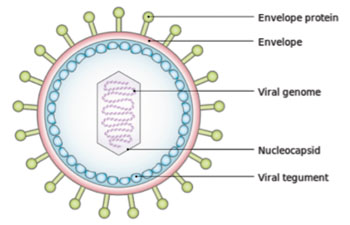Viral Oncogenes Short-Circuit Critical DNA Repair Mechanisms
By LabMedica International staff writers
Posted on 27 Mar 2014
A team of molecular biologists has used the oncogenic Epstein-Barr virus (EBV) to determine how DNA repair mechanisms become compromised to allow cells with damaged genomes to divide and proliferate.Posted on 27 Mar 2014
Organisms have built-in systems designed to protect them from cancer. Mechanisms to recognize errors in DNA lead to arrest of cell proliferation at various checkpoints to allow for repair. Suppression of these mechanisms is necessary for cancer cells to avoid these checkpoints and continue to divide.

Image: Schematic diagram of the Epstein-Barr virus (Photo courtesy of Wikimedia Commons).
To gain an understanding of the factors suppressing DNA repair mechanisms in cancer cells, investigators at Stony Brook University (New York, USA) used EBV as a source of oncogenes. This approach had shown previously that that EBV-driven cell proliferation required the cellular transcription factor STAT3 (signal transducer and activator of transcription 3). STAT3 is a member of the STAT protein family, which regulates many aspects of cell growth, survival, and differentiation. Malfunction of this signaling pathway is frequently observed in primary tumors and leads to increased angiogenesis and enhanced tumor survival. Knockout studies have provided evidence that Stat proteins are involved in the development and function of the immune system and play a role in maintaining immune tolerance and tumor surveillance. Constitutive STAT3 activation is associated with various human cancers and commonly suggests poor prognosis. It has antiapoptotic as well as proliferative effects. EBV infection is rapidly followed by activation and increased expression of STAT3.
The investigators reported in the March 17, 2014, online edition of the journal Proceedings of the National Academy of Sciences of the United States of America (PNAS) that while replication stress-associated DNA damage, which results from EBV infection, was detected by the DNA repair system, signaling downstream of ATR was impaired by STAT3, leading to relaxation of the intra-S phase checkpoint. ATR (Ataxia telangiectasia and Rad3 related) is a serine/threonine-specific protein kinase that is involved in sensing DNA damage and activating the DNA damage checkpoint, leading to cell cycle arrest. ATR is activated in response to persistent single-stranded DNA, which is a common intermediate formed during DNA damage detection and repair.
In particular, STAT3 interrupted ATR-to-Chk1 signaling by promoting loss of Claspin, a protein that assists ATR to phosphorylate Chk1. Chk1 (Checkpoint kinase 1) is a kinase that phosphorylates cdc25, an important phosphatase in cell cycle control, particularly for entry into mitosis. Claspin is an essential upstream regulator of Chk1 and triggers a checkpoint arrest of the cell cycle in response to replicative stress or DNA damage. The protein is also required for efficient DNA replication during a normal S phase.
“Our findings add to the short list of known mechanisms by which a key cellular antitumor barrier is breached by STAT3 prior to cancer development,” said senior author Dr. Sumita Bhaduri-McIntosh, assistant professor of pediatrics, molecular genetics, and microbiology at Stony Brook University School. “Because STAT3 interferes with this innate antitumor mechanism in cells, the opposite occurs when blood cells are infected in the lab with the cancer-causing virus EBV, and the cells continue to divide – a necessary step in cancer development.”
This newly recognized role for STAT3 in attenuation of the DNA repair mechanism, discovered in the context of EBV infection, should be of broad interest to life scientists, as the biology of cell proliferation is central to both health and disease.
Related Links:
Stony Brook University













